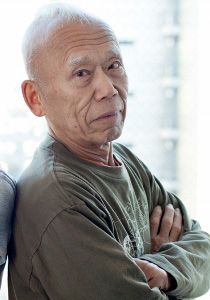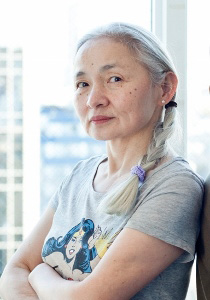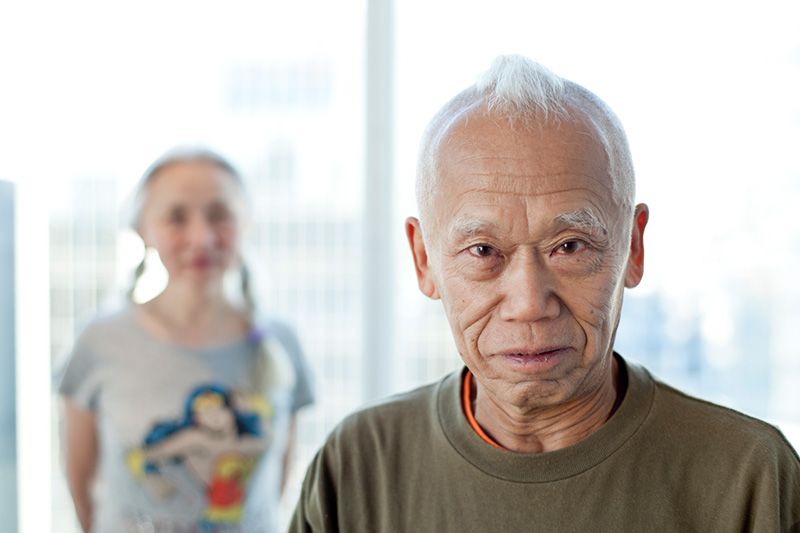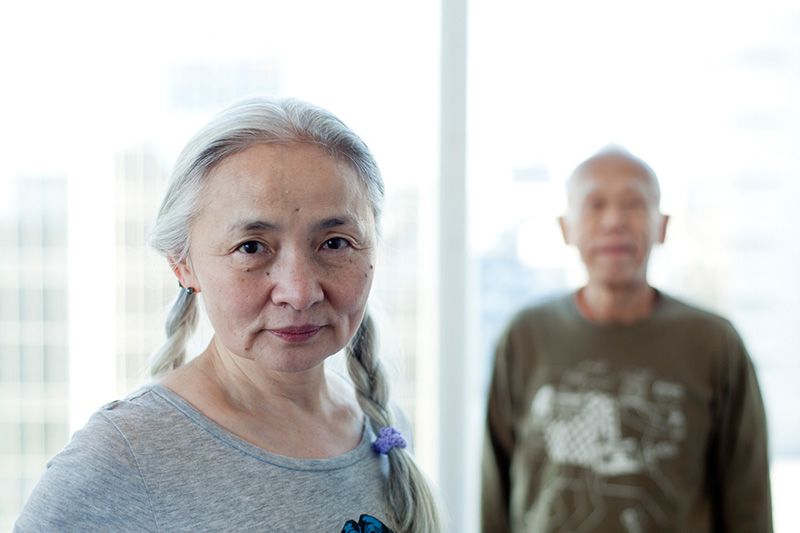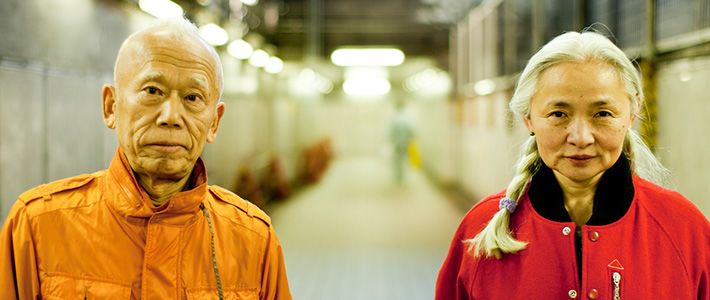
Shinohara Ushio and Noriko: A Couple Wrestles with the Demon Called Art
Culture- English
- 日本語
- 简体字
- 繁體字
- Français
- Español
- العربية
- Русский
Shinohara Ushio is a legendary artist once praised by no less a creator than Okamoto Tarō for his “over-the-top absurdity.” Together with his wife, Noriko, 21 years his junior, he lives in New York City, creating his art with surprising vigor for a man in his eighties.
Cutie and the Boxer, a 2013 film depicting the days of “love and conflict” lived by this Japanese couple, is now making an impact on the film world. It won a best documentary director award for Zachary Heinzerling at the 2013 Sundance Film Festival and has been nominated for a 2014 Academy Award in the documentary feature division.
More than a half-century has passed since Ushio dedicated himself to the world of art, and Noriko has been by his side for four of those decades. Why has their story, an underground one for so long, captivated contemporary filmgoers? What drives the Shinoharas’ passion for creative endeavor? Why did they go overseas, and what is their aim today after so many years of artistic expression? We spoke to the couple when they were in Japan for “Love Is A Roar-r-r-r! In Tokyo,” a month-long art show at the Parco Museum in Shibuya to mark the film’s Japan premier, to get answers to some of these questions.
A Brash Japanese Artist Takes On the World
“Art is a demon!” Ushio states this line as bare fact, without an artist’s affectation. He has lived the truth of this statement since the 1950s, when he wore his hair in a Mohawk style, well ahead of the punk movement. This marked the start of his media appearances as a wild child of the art world, but he drew still more attention in 1960, when he formed the Neo-Dadaism Organizers, an avant-garde group whose performances involved half-naked artists thrashing around on public streets.
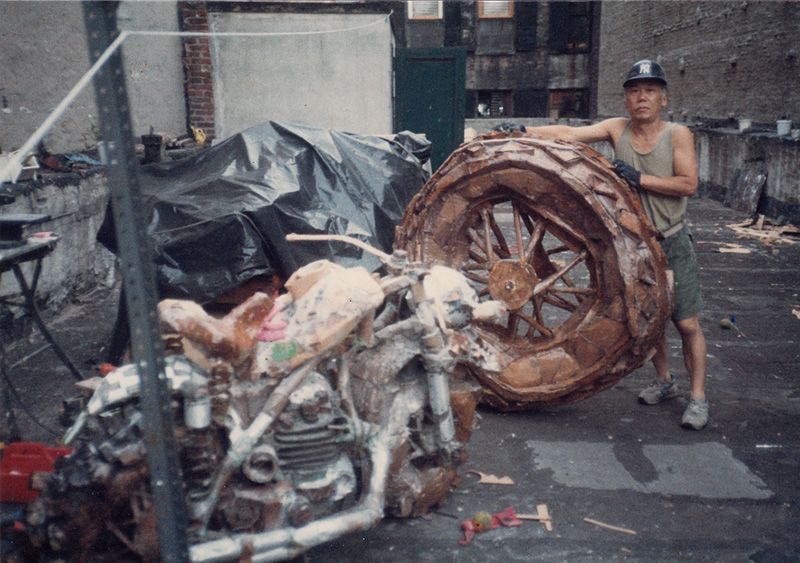 Ushio poses with a 1983 work from his cardboard Motorcycle Sculpture series in Dallas, Texas. (Courtesy Zazie Films.)
Ushio poses with a 1983 work from his cardboard Motorcycle Sculpture series in Dallas, Texas. (Courtesy Zazie Films.)
Ushio’s “boxing painting,” images created by bashing a wall with fists wrapped in ink-soaked cloth, gave him a name as an artist to watch—and perhaps to watch out for. It also got him noticed by the famed photographer and director William Klein, who captured Ushio in action in 1961 and published the photos in Tokyo, his influential 1964 collection. (Still shooting today, Klein photographed Ushio’s boxing painting in New York in 2012; the photos will appear in his forthcoming Brooklyn.)
In 1969 Ushio headed to New York. His efforts to make a name for himself there, however, were much less successful. Reduced to such poverty that he could no longer purchase art materials, he took to collecting discarded cardboard on the streets. He began fashioning this material into one of his representative series, the Motorcycle Sculptures. In this way, he has forged ahead in single-minded pursuit of his avant-garde artistic path, dreaming of the day he will make it big.
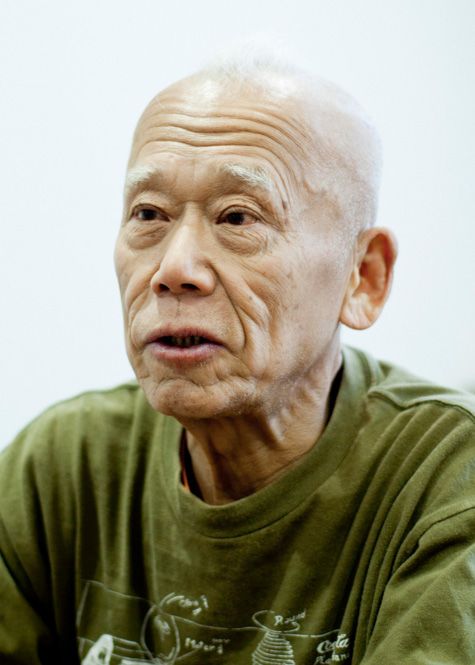 “More than anything else, I was attracted to the idea of American art,” says Ushio. “Around 1960, the pop art scene was booming. I’d stay up all night reading art magazine articles on it, and I got so excited. ‘I’m gonna do this too!’ So I took the plunge and headed to New York. For the first year I had a scholarship, but when that ran out, I had no money. No connections. Nothing. But I still had that demon called art. So all I could do was keep on bashing away at it with everything I had. And I’ve basically been bashing away like that ever since.”
“More than anything else, I was attracted to the idea of American art,” says Ushio. “Around 1960, the pop art scene was booming. I’d stay up all night reading art magazine articles on it, and I got so excited. ‘I’m gonna do this too!’ So I took the plunge and headed to New York. For the first year I had a scholarship, but when that ran out, I had no money. No connections. Nothing. But I still had that demon called art. So all I could do was keep on bashing away at it with everything I had. And I’ve basically been bashing away like that ever since.”
Noriko has a similar take: “Bashing away at it, sure, but the fact of the matter is that this was his only option, since he had no money to come back to Japan. He often talks about his time spent ‘in combat with art,’ but in our case the real battle has been just making a living. We’ve been on the edge of survival.”
“That’s right,” says Ushio. “In fact, the standard story is that I married you with my eye on your bank account.”
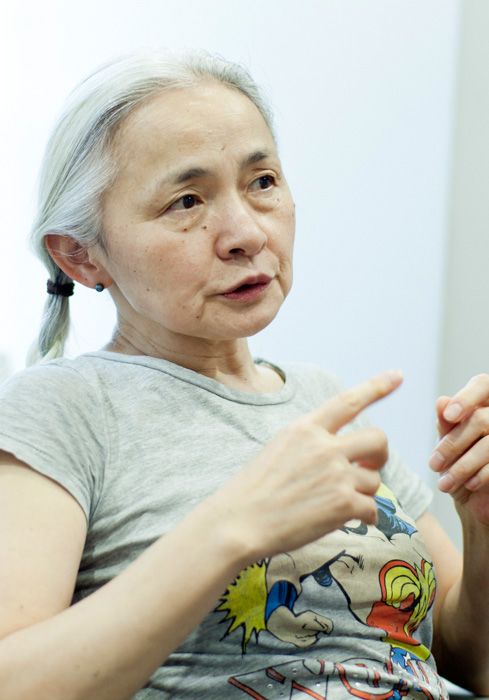 “Well you did, didn’t you?” snaps Noriko.
“Well you did, didn’t you?” snaps Noriko.
Ushio defends himself. “We live under the same roof. We’ve got the same job, creating art. There’s no reason not to share the same bank account.”
It was a bank account that remained close to empty, explains Noriko. All the money her family sent from Japan over the years ended up vanishing in the couple’s rent payments.
“But if you’re an artist,” Ushio goes on, “you’ve absolutely got to have a large space to create in. In America, if your images are small in scale, they’re nothing more than trash. There we were, in the epicenter of the global art scene. The only way to make it there is to stay ambitious—to be willing to kick everyone else to the side and make it to the top of the heap, with guys like Andy Warhol and Jasper Jones. Without that ambition you’re nothing.”
A Home Steeped in Art . . . and Jealousy
The couple’s words perfectly encapsulate their history as it was captured in Heinzerling’s documentary on their art, Cutie and the Boxer. As a new high-school graduate, Noriko moved to New York to pursue art studies in the early 1970s, at the age of 19. The era of the fixed exchange rate of 360 yen to the dollar was at an end, making such a move relatively affordable for the first time. A half-year into her time in New York she met Ushio. Just three years later, in 1974, their son, Alexander Kūkai Shinohara, was born. This marked the beginning of their long years of “love and conflict.”
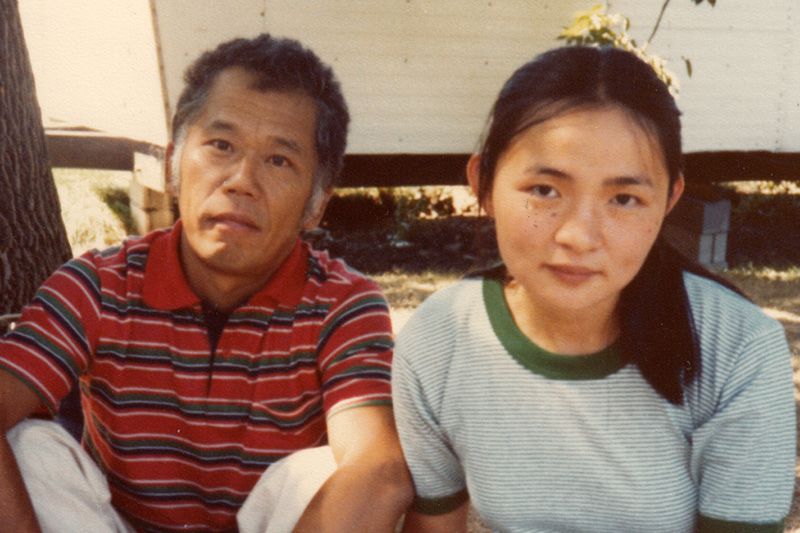 An undated family photo of Ushio and Noriko in their younger days. (Courtesy Zazie Films.)
An undated family photo of Ushio and Noriko in their younger days. (Courtesy Zazie Films.)
It has been a tumultuous time for the family, explains Ushio, especially because all three of them are artists. “Every single day is intense. And we certainly aren’t working together in some collaboration. We’re such totally different individuals from different generations. If Noriko starts receiving praise for her work, then I have to tell you, it ticks me off! But that’s just how it has to be. When Isamu Noguchi was asked where he got his creative energy, he had the same answer: from jealousy!”
Noriko chimes in: “My husband is such a jealous man! Take the documentary we’re in. At first Zach [Heinzerling] focused mainly on him, but over time he got more interested in my work. In the later part of the filming there were days when he’d shoot only me and then go home. When Ushio asked why he’d left already, I’d make up some story about how busy the director was.”
A Portrait of Artistic and Family Struggle
 Ushio’s approach to the relationship seems to be summed up in his statement, “It’s up to the average to support people of genius.” Indeed, during the first half of Cutie and the Boxer, Noriko appears mainly as a wife, a mother, and at times an art assistant to her husband. But as the film progresses, the comics she draws, featuring a clearly autobiographical “Cutie” as the main character, become a core theme advancing the narrative.
Ushio’s approach to the relationship seems to be summed up in his statement, “It’s up to the average to support people of genius.” Indeed, during the first half of Cutie and the Boxer, Noriko appears mainly as a wife, a mother, and at times an art assistant to her husband. But as the film progresses, the comics she draws, featuring a clearly autobiographical “Cutie” as the main character, become a core theme advancing the narrative.
The two agree that in filming the documentary, Heinzerling also underwent considerable change. Ushio notes: “When Zach first showed up, he was this skinny, good-looking kid—and a slowpoke when it came to his work. I had to take the lead by performing for him. I’d shout out that it was time to rub myself down with a dry towel or something. Pull off my clothes on the spot and start massaging myself for his camera.”
“An artist is an exhibitionist,” adds Noriko. You can’t get all self-conscious just because someone is filming you. And Ushio has had plenty of experience dealing with media types over the years.” However, as she notes, all of his over-the-top performances ended up on the cutting room floor. Despite the filming taking more than four years, the final product is primarily about the final year of that period. “At first Zach would come by a couple times a week, and he’d be shooting things like the dirtiest spots on our floor or in our sink. The cat’s tail. I figured we’d never get a movie out of him. You could shoot footage like that for a decade and have nothing to show for it.”
Heinzerling was just 24 years old when he began working with the Shinoharas. Over the course of nearly five years, he built up a relationship of trust with his subjects as he developed his own skill for spinning the tale of their relationship.
Noriko explains the director’s growth. “Eventually, he became almost like a piece of furniture in our house—something we paid no attention to whatsoever. Zach likes to say that it took time for me to open my heart to his observation, but from my perspective, it also took him time to develop as an observer.”
Ushio agrees. “That guy matured during the time he spent with Noriko and me. He was just a regular kid. Grew up eating good food in a regular home. So at first he had the most ridiculous questions for us. ‘Are you two not in love with one another?’ or ‘Could I film you having a couple’s spat?’ or the like. I wondered what the hell he thought he was doing.”
“There’s no way he could film us fighting if he wasn’t living right there with us,” adds Noriko. She had her own suggestions for the documentary: the scene where she and Ushio put on boxing gloves soaked in paint and flail away at each other and the animated scene using her pictures of Cutie. But she remains unsatisfied with the final cut of the film, though: “Our real life has been much more wretched than you can see in this movie. I mean really, we have no idea what’s going to happen to us next. Our immediate future is like a black void!”
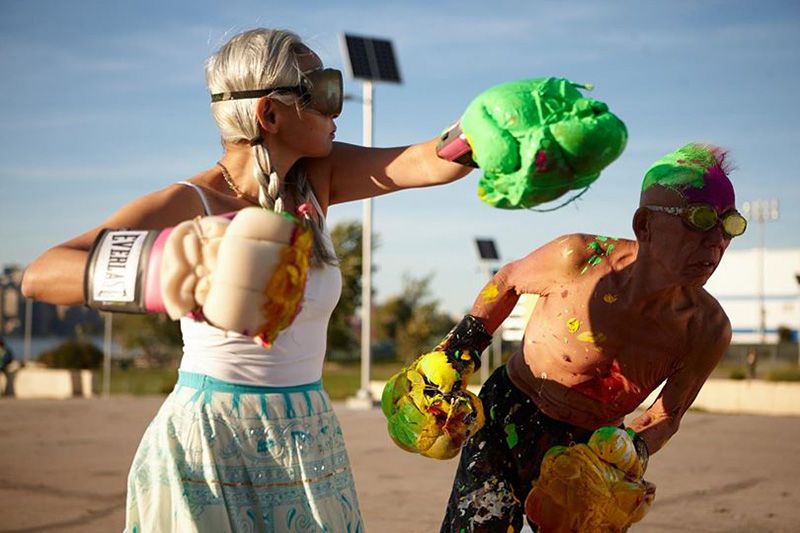 The action scene from Cutie and the Boxer. © Ex Lion Tamer, Inc. All rights reserved.
The action scene from Cutie and the Boxer. © Ex Lion Tamer, Inc. All rights reserved.
“So what?” objects Ushio. “It’s still the kind of movie that leaves people in tears! We toured America giving preview showings of it, and every single time we walked into a theater after the credits rolled, we’d get a standing, weeping ovation. I was shocked to see this power that movies have to attack people right in their heartstrings! It’s something that pictures don’t have.”
Things have changed for Ushio since the film came out, with people calling his name when they see him on the street. “I’m a celebrity now, so I’d better start acting like a proper star. If this helps me sell a bunch of pictures, well then, that’s going to be great!”
The path an artist takes may seem like a pleasant one, but the Shinoharas show that it can literally require putting your life on the line. They have not chosen to seek cheap recognition through ostentatious self-exposure or by catering to the whims of the art market. They clearly value above all else the thrill that comes from the act of creation itself. A successful film is now sharing their lives with audiences around the world, but it seems unlikely that this gift from that demon known as art will deter Cutie and her Boxer from pursuing the love and conflict that have driven those lives so far.
(Originally written in Japanese by Fukasawa Keita based on a December 15, 2013, interview. Interview photos by Igarashi Kazuharu.)
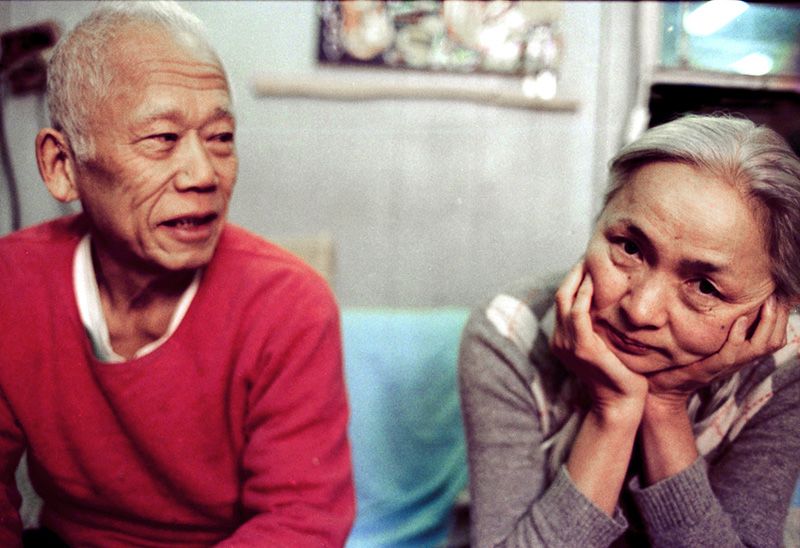 • Cutie and the Boxer is playing in select theaters in Japan. For details, see the website (in Japanese): www.cutieandboxer.com
• Cutie and the Boxer is playing in select theaters in Japan. For details, see the website (in Japanese): www.cutieandboxer.com• Courtesy King Records and Parco.
• Distribution by Zazie Films and Parco.
© 2013 Ex Lion Tamer, Inc. All rights reserved.
art Painting film Shinohara documentary performance Ushio Noriko New York Boxing Academy Award Oscar Sundance Zachary Heinzerling Cutie and the Boxer
